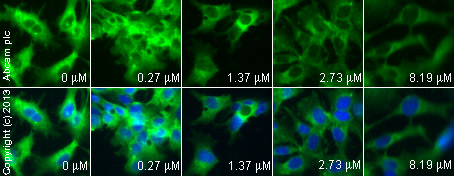
ab15191 staining COX2 in HepG2 cells treated with sinomenine hydrochloride (ab141190), by ICC/IF. Decrease of COX2 expression correlates with increased concentration of sinomenine hydrochloride, as described in literature.The cells were incubated at 37°C for 48 hours in media containing different concentrations of ab141190 (sinomenine hydrochloride) in DMSO, fixed with 4% formaldehyde for 10 minutes at room temperature and blocked with PBS containing 10% goat serum, 0.3 M glycine, 1% BSA and 0.1% tween for 2h at room temperature. Staining of the treated cells with ab15191 (5 µg/ml) was performed overnight at 4°C in PBS containing 1% BSA and 0.1% tween. A DyLight 488 anti-rabbit polyclonal antibody (ab96899) at 1/250 dilution was used as the secondary antibody. Nuclei were counterstained with DAPI and are shown in blue.
Go to product page
Image may be subject to copyright.